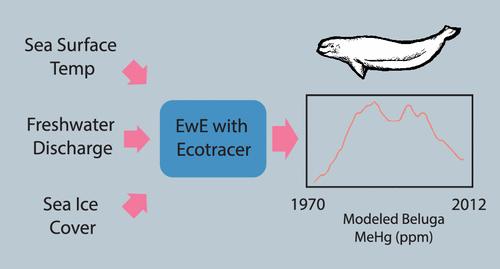Exploring Drivers of Historic Mercury Trends in Beluga Whales Using an Ecosystem Modeling Approach
IF 6.7
Q1 ENGINEERING, ENVIRONMENTAL
引用次数: 0
Abstract
While mercury occurs naturally in the environment, human activity has significantly disturbed its biogeochemical cycle. Inorganic mercury entering aquatic systems can be transformed into methylmercury, a strong neurotoxicant that builds up in organisms and affects ecosystem and public health. In the Arctic, top predators such as beluga whales, an ecologically and culturally significant species for many Inuit communities, can contain high concentrations of methylmercury. Historical mercury concentrations in beluga in the western Canadian Arctic’s Beaufort Sea cannot be explained by mercury emission trends alone; in addition, they could potentially be driven by climate change impacts, such as rising temperatures and sea ice melt. These changes can affect mercury bioaccumulation through different pathways, including ecological and mercury transport processes. In this study, we explore key drivers of mercury bioaccumulation in the Beaufort Sea beluga population using Ecopath with Ecosim, an ecosystem modeling approach, and scenarios of environmental change informed by Western Science and Inuvialuit Knowledge. Comparing the effect of historical sea ice cover, sea surface temperature, and freshwater discharge time series, modeling suggests that the timing of historical increases and decreases in beluga methylmercury concentrations can be better explained by the resulting changes to ecosystem productivity rather than by those to mercury inputs and that all three environmental drivers could partially explain the decrease in mercury concentrations in beluga after the mid-1990s. This work highlights the value of multiple knowledge systems and exploratory modeling methods in understanding environmental change and contaminant cycling. Future work building on this research could inform climate change adaptation efforts and inform management decisions in the region.

利用生态系统建模方法探索白鲸汞历史趋势的驱动因素
虽然汞天然存在于环境中,但人类活动极大地干扰了汞的生物地球化学循环。进入水生系统的无机汞可转化为甲基汞,这是一种强烈的神经毒剂,会在生物体内积聚,影响生态系统和公众健康。在北极地区,白鲸等顶级食肉动物可能含有高浓度的甲基汞,而白鲸对许多因纽特社区来说是一种具有重要生态和文化意义的物种。加拿大西部北极波弗特海白鲸体内的历史汞浓度不能仅用汞排放趋势来解释;此外,它们还可能受到气候变化的影响,如气温上升和海冰融化。这些变化会通过不同途径影响汞的生物累积,包括生态和汞迁移过程。在这项研究中,我们利用生态系统建模方法 Ecosim 中的 Ecopath 以及西方科学和因纽维阿鲁特知识(Inuvialuit Knowledge)提供的环境变化情景,探讨了波弗特海白鲸种群汞生物累积的关键驱动因素。通过比较历史上海冰覆盖率、海面温度和淡水排放时间序列的影响,建模表明,历史上白鲸甲基汞浓度增加和减少的时间可以更好地用生态系统生产力的变化而不是汞输入的变化来解释,而且所有三个环境驱动因素都可以部分解释 20 世纪 90 年代中期以后白鲸体内汞浓度的下降。这项工作凸显了多种知识体系和探索性建模方法在理解环境变化和污染物循环方面的价值。在此研究基础上开展的未来工作可为该地区适应气候变化的努力和管理决策提供信息。
本文章由计算机程序翻译,如有差异,请以英文原文为准。
求助全文
约1分钟内获得全文
求助全文
来源期刊

ACS Environmental Au
环境科学-
CiteScore
7.10
自引率
0.00%
发文量
0
期刊介绍:
ACS Environmental Au is an open access journal which publishes experimental research and theoretical results in all aspects of environmental science and technology both pure and applied. Short letters comprehensive articles reviews and perspectives are welcome in the following areas:Alternative EnergyAnthropogenic Impacts on Atmosphere Soil or WaterBiogeochemical CyclingBiomass or Wastes as ResourcesContaminants in Aquatic and Terrestrial EnvironmentsEnvironmental Data ScienceEcotoxicology and Public HealthEnergy and ClimateEnvironmental Modeling Processes and Measurement Methods and TechnologiesEnvironmental Nanotechnology and BiotechnologyGreen ChemistryGreen Manufacturing and EngineeringRisk assessment Regulatory Frameworks and Life-Cycle AssessmentsTreatment and Resource Recovery and Waste Management
 求助内容:
求助内容: 应助结果提醒方式:
应助结果提醒方式:


